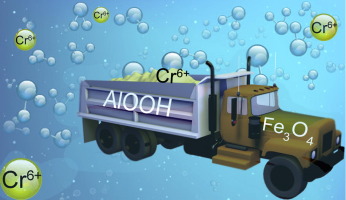Authors: Shapovalova O. E., Drozdov A. S., Bryushkova E.A., Morozov M. I., Vinogradov V.V.

Abstract
Magnetite-boehmite porous ceramic composites were synthesized from magnetite and boehmite hydrosols in a course of room-temperature sol-gel transition. The proposed synthesis routine allowed producing ceramic matrices with a high degree of structure homology, realizing the full range of composites combining magnetite and boehmite phases at any mass ratio. Depending on the magnetite to boehmite ratio the total surface area of the composites can be varied from 122 to 391 m2/g while the magnetization of the composites can reach up to 88 emu/g. The synthesized composites were examined as adsorbent for Cr(VI) ions and showed the pseudo-second order sorption kinetics. The characterized adsorption behavior was in best accord with the Langmuir model, showing the maximum adsorption capacities of Cr(VI) ions up to 62.4 mg/g. Owing to their magnetic properties the magnetite-containing composites can be magnetically separated and reused for up to 5 times with only minor drop to the sorption capacity down to 89% of its initial value. These make the magnetite-boehmite composites prospective for various applications, including wastewater treatment.
DOI:10.1016/j.arabjc.2018.02.011
Read Full:
https://www.sciencedirect.com/science/article/pii/S1878535218300509?via%3Dihub